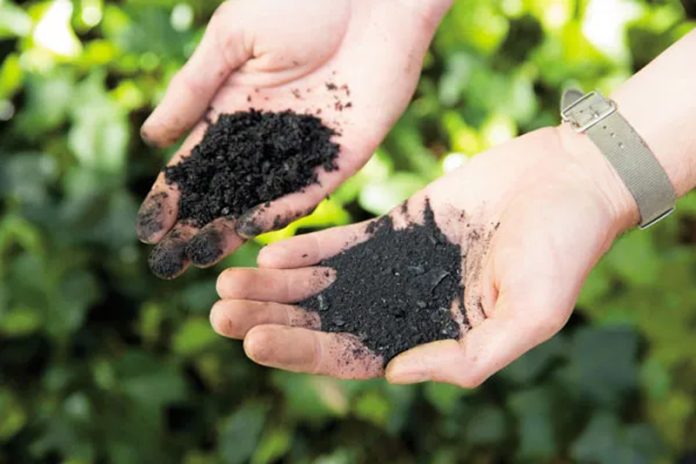Ashima Choudhary, Divyansh Verma
To ensure the food supply for a growing global population, agricultural production must be intensified on a worldwide scale. Consequently, there is a significant decline in soil quality when the soil’s organic carbon content decreases. The amount of organic carbon in soil has decreased due to intensive agriculture and horticulture, from an estimated 3 percent to less than 1 percent. The presence of organic carbon in the soil promotes the growth of soil biota, which supports nutrient flow mechanisms and increases the capacity of cation exchange, water and nutrient retention. One way to improve soil health is by the application of carbonized materials (biochars), which have long-term stability. Biochar is referred to as ‘Black Gold’ a carbonaceous material made from heating organic material such as agricultural waste, wood chips or other biomass in a low or no oxygen environment. This process known as pyrolysis, produces a stable form of carbon that does not decompose easily, allowing it to persist in the soil for ages. Biochar exhibits unique performance characteristics in concrete due to a number of important qualities, such as low bulk density, low heat conductivity, and porous nature. Additionally, it seems that this can lower emissions of N2O and CH4 from soil.
Biochar Production and It’s Versatility
Pyrolysis is a well-established process that can be scaled from small to big industrial operations and is used in the manufacture of biochar. Because of its adaptability, biochar is a flexible solution that may be used to solve a range of environmental, agricultural, and economic concerns in different settings and situations. Pyrolysis is one of the methods for converting biomass into a liquid intermediate that can be further processed to produce petrochemical substitutes, oxygenated fuel additives, and hydrocarbon biofuels that can be added to gasoline. In order to provide enough heat to break down the strong bio-polymers, biomass pyrolysis is often carried out at 500 °C or higher. In the absence of oxygen, the biomass thermally breaks down into combustible gases and charcoal rather than combusting. Thus, pyrolysis of biomass produces three products: one liquid, bio-oil, one solid, bio-char, and one gaseous, syngas.
Benefits of Biochar
Carbon Sequestration: It mitigates the effect of climate change by acting as a carbon sink and absorbing atmospheric CO2 in a stable form.Possibility of storing up to 2 billion tons of carbon dioxide per year by 2050-nearly twice as much as India produces currently.
Agricultural Productivity: A healthier habitat for plants and higher agricultural yields are the results of biochar’s improvements to soil fertility, water holding capacity and nutrient uptake.
Soil Remediation: Biochar is frequently utilized to treat soil that has been contaminated by heavy metals.
Fire resistance: Because of their steady physiochemical features, composites treated with biochar exhibited comparatively good fire resistance as compared to those incorporating wood.
Reduction in Methane Emissions: Methane emissions are reduced because it creates soil conditions that suppress organisms that produce methane.
Waste Utilization: Produces biochar from organic and agricultural residues, cutting down on landfill garbage and offering a beneficial soil supplement.
Biochar used for carbon sequestration:
The creation and application of biochar has drawn attention as a potential method for lowering atmospheric carbon dioxide concentrations in recent years. There are possible direct and indirect ways to accomplish this.Biochar, a sustainable solid material derived from biomass pyrolysis enriched in carbon, has emerged as a promising solution for soil carbon sequestration.The primary factor contributing to biochar’s reputation as a direct method of sequestering carbon is its refractory carbon content, which resists micro-organisms’ ability to break it down and can withstand hundreds or even thousands of years in the environment.The carbon in biomass is stabilized and locked away by turning it into biochar, which stops it from being quickly released back into the atmosphere as carbon dioxide, as would normally happen when the biomass feedstock is consumed or breaks down.Therefore, growing biomass for the formation of biochar has the net effect of sequestering atmospheric carbon dioxide in the soil in a stable form, assuming that the biomass used to make the biochar is replenished.
By enhancing soil quality and retaining more water and nutrients, biochar has the potential to reduce greenhouse gas emissions caused by human activity in an indirect manner.As a result, the soil becomes less acidic and becomes a more favorable home for helpful soil microbes. These advancements have the potential to lower the requirement for synthetic fertilizers, a source of greenhouse gas emissions, and raise agricultural production. A higher organic carbon content indicates a greater potential for carbon sequestration.
Future prospects
Biochar’s importance in agricultural and environmental sustainability is predicted to rise as research advances and commercial uses become more accessible. It presents a possible answer to some of the most urgent global concerns.
In the fight for climate change mitigation and sustainable agriculture, biochar is a substantial breakthrough. Its ability to boost agriculture, sequester carbon and use waste makes it a vital component in the shift to a more ecologically friendly and sustainable future. However, further study, technological developments, and legislative assistance are needed for biochar to realize its full potential.
( The authors are Ph. D Scholars, SKUAST- Jammu)


